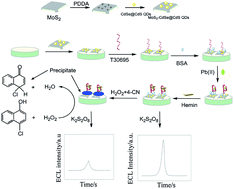当前位置:
X-MOL 学术
›
Anal. Methods
›
论文详情
Our official English website, www.x-mol.net, welcomes your feedback! (Note: you will need to create a separate account there.)
An electrochemiluminescence sensor based on CdSe@CdS functionalized MoS2 and hemin/G-quadruplex-based DNAzyme biocatalytic precipitation for sensitive detection of Pb(ii)
Analytical Methods ( IF 3.1 ) Pub Date : 2017-11-21 00:00:00 , DOI: 10.1039/c7ay02334k Xiao-Li Du 1, 2, 3, 4, 5 , Tian-Fang Kang 1, 2, 3, 4, 5 , Li-Ping Lu 1, 2, 3, 4, 5 , Shui-Yuan Cheng 1, 2, 3, 4, 5
Analytical Methods ( IF 3.1 ) Pub Date : 2017-11-21 00:00:00 , DOI: 10.1039/c7ay02334k Xiao-Li Du 1, 2, 3, 4, 5 , Tian-Fang Kang 1, 2, 3, 4, 5 , Li-Ping Lu 1, 2, 3, 4, 5 , Shui-Yuan Cheng 1, 2, 3, 4, 5
Affiliation

|
A novel electrochemiluminescence (ECL) biosensor based on CdSe@CdS quantum dots (QDs) functionalized MoS2 modified electrode was developed for sensitive detection of Pb(II) using HRP-mimicking DNAzyme biocatalytic precipitation (BCP) for ECL signal quenching. Polycationic poly(diallyldimethylammonium chloride) (PDDA) and negatively charged QDs were adsorbed on the surface of MoS2, in sequence, to form the MoS2–QDs composites, which were employed as a matrix for the immobilization of the G-rich DNA strand, i.e., T30695. The MoS2–QDs were characterized by UV-vis absorption spectroscopy, fluorescence spectroscopy, energy dispersive spectrometry, transmission electron microscopy, and field emission scanning electron microscopy. CdSe@CdS QDs can produce an ECL signal using 0.1 M K2S2O8 as a co-reactant. T30695 can combine with Pb(II) ions to form a stable parallel G-quadruplex. The G-quadruplex can further combine with hemin to form DNAzyme, which can catalyze H2O2 and oxidize 4-chloro-1-naphthol (4-CN) to produce an insoluble precipitation of benzo-4-chlorohexadienone on the surface of the sensor. When the concentration of Pb(II) in the solution was increased, more of DNAzyme was generated and subsequently more 4-CN molecules were oxidized catalytically, leading to a decrease of the ECL signal. Using this quenching strategy, the ECL signal of the biosensor was linearly dependent on the logarithm of the Pb(II) concentration ranging from 1.0 × 10−15 to 1.0 × 10−11 M with a detection limit of 0.98 f M. The stability and selectivity of the sensor were also investigated. The sensor was applied in the determination of Pb(II) in the real water samples and satisfactory results were obtained.
中文翻译:

基于CdSe @ CdS功能化的MoS 2和基于血红素/ G-四链体的DNA酶生物催化沉淀的电化学发光传感器,用于Pb(ii)的 灵敏检测
开发了一种基于CdSe @ CdS量子点(QDs)功能化的MoS 2修饰电极的新型电化学发光(ECL)生物传感器,用于使用HRP模拟DNAzyme生物催化沉淀(BCP)进行ECL信号猝灭的灵敏检测Pb(II)。将聚阳离子聚二烯丙基二甲基氯化铵(PDDA)和带负电荷的QD依次吸附在MoS 2的表面上,形成MoS 2 -QDs复合材料,将其用作固定富G DNA链的基质,我。例如T30695。MoS 2–QD通过紫外可见吸收光谱,荧光光谱,能量色散光谱,透射电子显微镜和场发射扫描电子显微镜进行表征。CdSe @ CdS QD可以使用0.1 MK 2 S 2 O 8作为共反应物来产生ECL信号。T30695可与Pb(II)离子结合形成稳定的平行G四联体。G-四链体可以进一步与血红素结合形成DNA酶,该酶可以催化H 2 O 2并氧化4-氯-1-萘酚(4-CN),从而在其表面产生不溶性的苯并4-氯己二酮沉淀。传感器。当Pb(II溶液中)的增加,产生了更多的DNAzyme,随后更多的4-CN分子被催化氧化,导致ECL信号降低。使用这种淬灭策略,生物传感器的ECL信号线性依赖于Pb(II)浓度的对数,范围为1.0×10 -15至1.0×10 -11 M,检测极限为0.98 fM。还研究了传感器的选择性。该传感器用于实际水样中铅(Ⅱ)的测定,结果令人满意。
更新日期:2017-11-21
中文翻译:

基于CdSe @ CdS功能化的MoS 2和基于血红素/ G-四链体的DNA酶生物催化沉淀的电化学发光传感器,用于Pb(ii)的 灵敏检测
开发了一种基于CdSe @ CdS量子点(QDs)功能化的MoS 2修饰电极的新型电化学发光(ECL)生物传感器,用于使用HRP模拟DNAzyme生物催化沉淀(BCP)进行ECL信号猝灭的灵敏检测Pb(II)。将聚阳离子聚二烯丙基二甲基氯化铵(PDDA)和带负电荷的QD依次吸附在MoS 2的表面上,形成MoS 2 -QDs复合材料,将其用作固定富G DNA链的基质,我。例如T30695。MoS 2–QD通过紫外可见吸收光谱,荧光光谱,能量色散光谱,透射电子显微镜和场发射扫描电子显微镜进行表征。CdSe @ CdS QD可以使用0.1 MK 2 S 2 O 8作为共反应物来产生ECL信号。T30695可与Pb(II)离子结合形成稳定的平行G四联体。G-四链体可以进一步与血红素结合形成DNA酶,该酶可以催化H 2 O 2并氧化4-氯-1-萘酚(4-CN),从而在其表面产生不溶性的苯并4-氯己二酮沉淀。传感器。当Pb(II溶液中)的增加,产生了更多的DNAzyme,随后更多的4-CN分子被催化氧化,导致ECL信号降低。使用这种淬灭策略,生物传感器的ECL信号线性依赖于Pb(II)浓度的对数,范围为1.0×10 -15至1.0×10 -11 M,检测极限为0.98 fM。还研究了传感器的选择性。该传感器用于实际水样中铅(Ⅱ)的测定,结果令人满意。


























 京公网安备 11010802027423号
京公网安备 11010802027423号